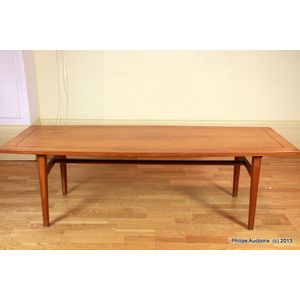French Moderne Oak Dressing Table
You must be a subscriber, and be logged in to view price and dealer details.
Subscribe Now to view actual auction price for this item
When you subscribe, you have the option of setting the currency in which to display prices to $Au, $US, $NZ or Stg.
- Circa - A Latin term meaning 'about', often used in the antique trade to give an approximate date for the piece, usually considered to be five years on either side of the circa year. Thus, circa 1900 means the piece was made about 1900, probably between 1895 and 1905. The expression is sometimes abbreviated to c.1900.
- Oak - Native to Europe and England, oak has been used for joinery, furniture and building since the beginning of the medieval civilisation. It is a pale yellow in colour when freshly cut and darkens with age to a mid brown colour.
Oak as a furniture timber was superceded by walnut in the 17th century, and in the 18th century by mahogany,
Semi-fossilised bog oak is black in colour, and is found in peat bogs where the trees have fallen and been preserved from decay by the bog. It is used for jewellery and small carved trinkets.
Pollard oak is taken from an oak that has been regularly pollarded, that is the upper branches have been removed at the top of the trunk, result that new branches would appear, and over time the top would become ball-like. . When harvested and sawn, the timber displays a continuous surface of knotty circles. The timber was scarce and expensive and was used in more expensive pieces of furniture in the Regency and Victorian periods. - Faux - A French word meaning "false", but when used in decorative arts, the intention is not to deceive, but to simulate the decorative effects of the more expensive material it is imitating. The term " faux bois" meaning "false wood" refers to a furniture item that has been decorated with a marked grain (woodgrain finish) to imitate a more expensive timber.
Visually similar items

Georgian oak games table with fold out top and gate leg support, 91 cm wide, 74 cm high

A teak coffee table, circa 1950-60s, in the Fler style but unmarked, the rectangular table with convex sides, with stringing and edging, and upon gently tapering square legs with a shaped H-form stretcher. Height 46 cm. Length 151 cm. Width 58 cm

A Sherton revival mahogany three drawer writing table with inset leather top on square tapering legs. 76 cm high, 124 cm long, 65 cm depth

A Georgian mahogany fold over games table, early 19th century, of simple rectangular form with fold out lopers and having a single cockbeaded frieze drawer with a brass ring pull and supported by tapering squared legs. Height 75 cm. Length 91 cm. Width 44
